|
History
Questions
Preparation
Root searching
Documentation
|
--History--
We are members of Chang Shu Elementary
School Choir. Though we are the third
generation, details about Amis culture
seemed to be vague and confusing to us.
Though most of our grandparents were
originally from Jinpu Township of Hualien
County, they don’t seem to be completely
aware of Amis culture. Fortunately, we have
been getting opportunities to explore
traditional dance and songs in Amis culture
through the choir practices. In addition, we
learned more about traditional Amis
costumes, utensils, and customs, legendary
tales, and more. As we progress, we raise
more questions about Amis culture…Top
--Questions--
Our peers and we had many questions about
Amis culture. We hope to get answers to the
following questions:
1•Why
did our grandparents migrate from Jinpu
Township of Hualien County to Shanguang
Community in Shijr City of Taipei County?
2•Why
are Taiwanese aboriginals are known for
frequent alcohol drinkers?
3•What
types of animals and plants were there in
our homeland and how were they used?
4•What
is the ecological fishing method used in
traditional Amis fishing?
5•Why
does Amis culture have a matrilineal
society?
6•What
are the traditional utensils referred in
Amis culture?
7•We
would like to learn more about traditional
crafts and arts.
8•What
are some of the distinctive features of Amis
dining culture?
9•Where
was the origin of Amis culture?
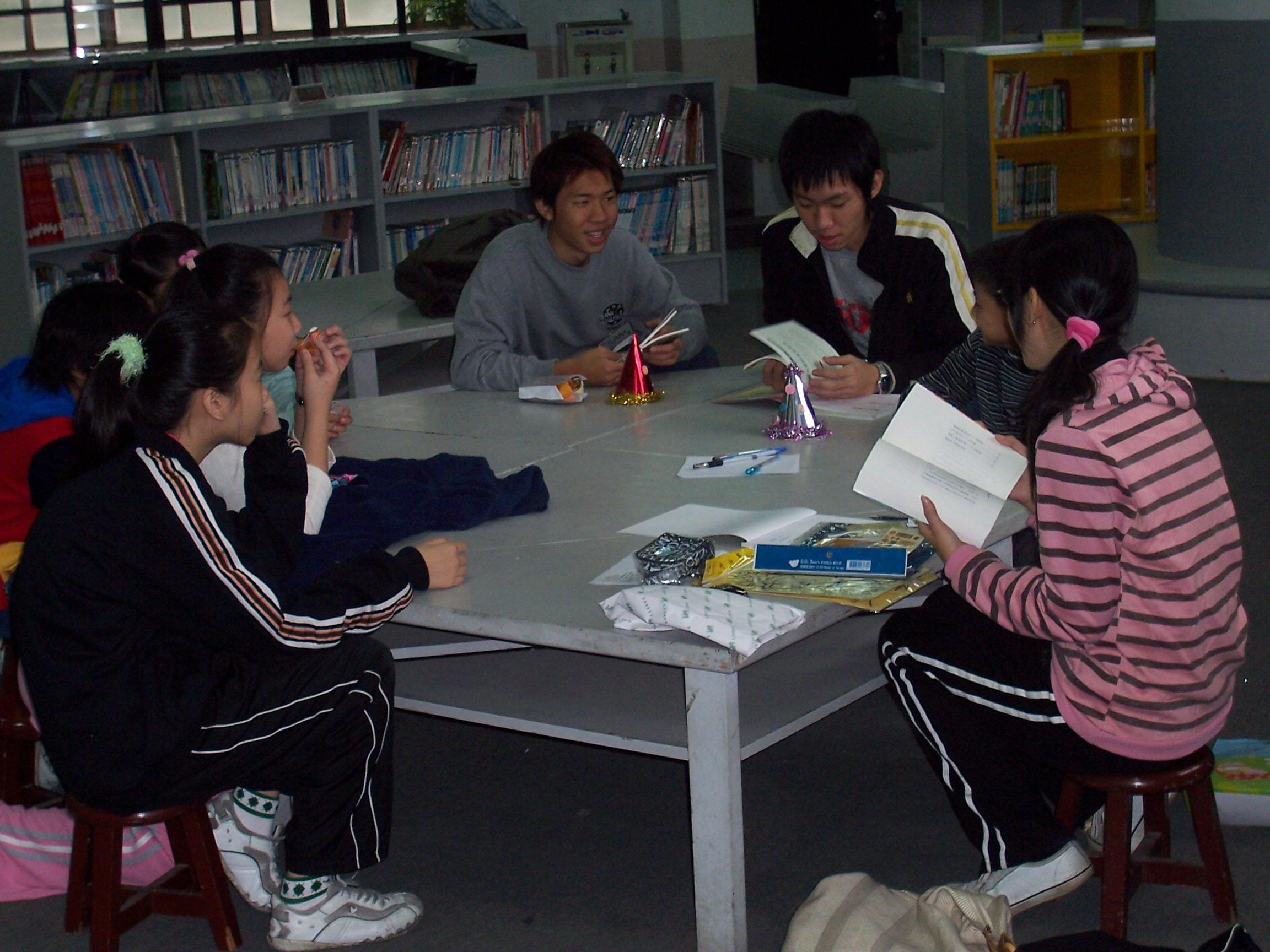
Chatting with volunteer advisors from
Christian Chun Cheng University.
Because our instructor did not have answers
to all of our questions, we were put on hold
until our school has complete answers for
us. By coincident, the Christian Chun Cheng
University’s volunteer advisors, who taught
our computer courses every Saturday, were
enthusiastic about helping us in finding
answers after a few discussions.Top
--Preparation--
The volunteer advisors had planned a series
of educational activities for our
root-searching trip and we expected to gain
invaluable knowledge and experience that
last for our lifetime.
Before we started our journey, we were
scheduled for a number of courses designed
to help us in interviews and documentation
as well as information integration:
--Information
Learning--
During the preparation phase, our volunteer
advisors from Christian Chun Cheng
University designed several courses for
information technology to help us in
information integration and documentation.
During the course of study, we not only
learned to manage the information we
gathered and trip photos using tables and
charts in Word but also gained knowledge in
simple editing tasks. These courses have
been beneficial to all of us.
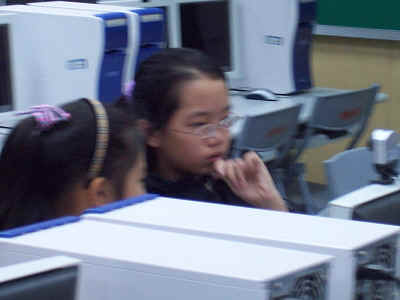
Discussing and brainstorming problems we
encountered.

Focusing on absorbing information from the
class.
--Interview
Learning--
On the day before our trip, we were
scheduled for a course for improving
interview skills. During the course of
study, we learned tips and pointers about
conducting an interview effectively through
a number of interview practices with our
volunteer advisors.

Focusing on learning a list of things to be
aware during interviews.

Trying to interview one of the volunteer
advisors who was photographing.
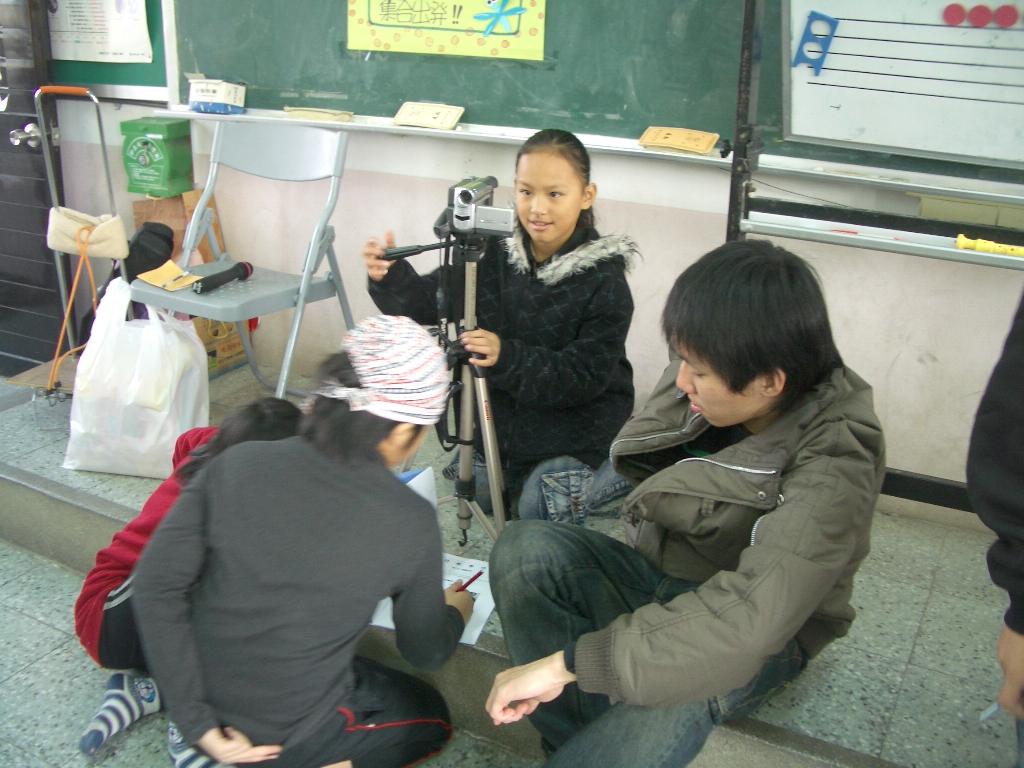
Trying to learn how to operate a camera.Top
--Root searching--
Through learning, we continue to grow our
knowledge!!
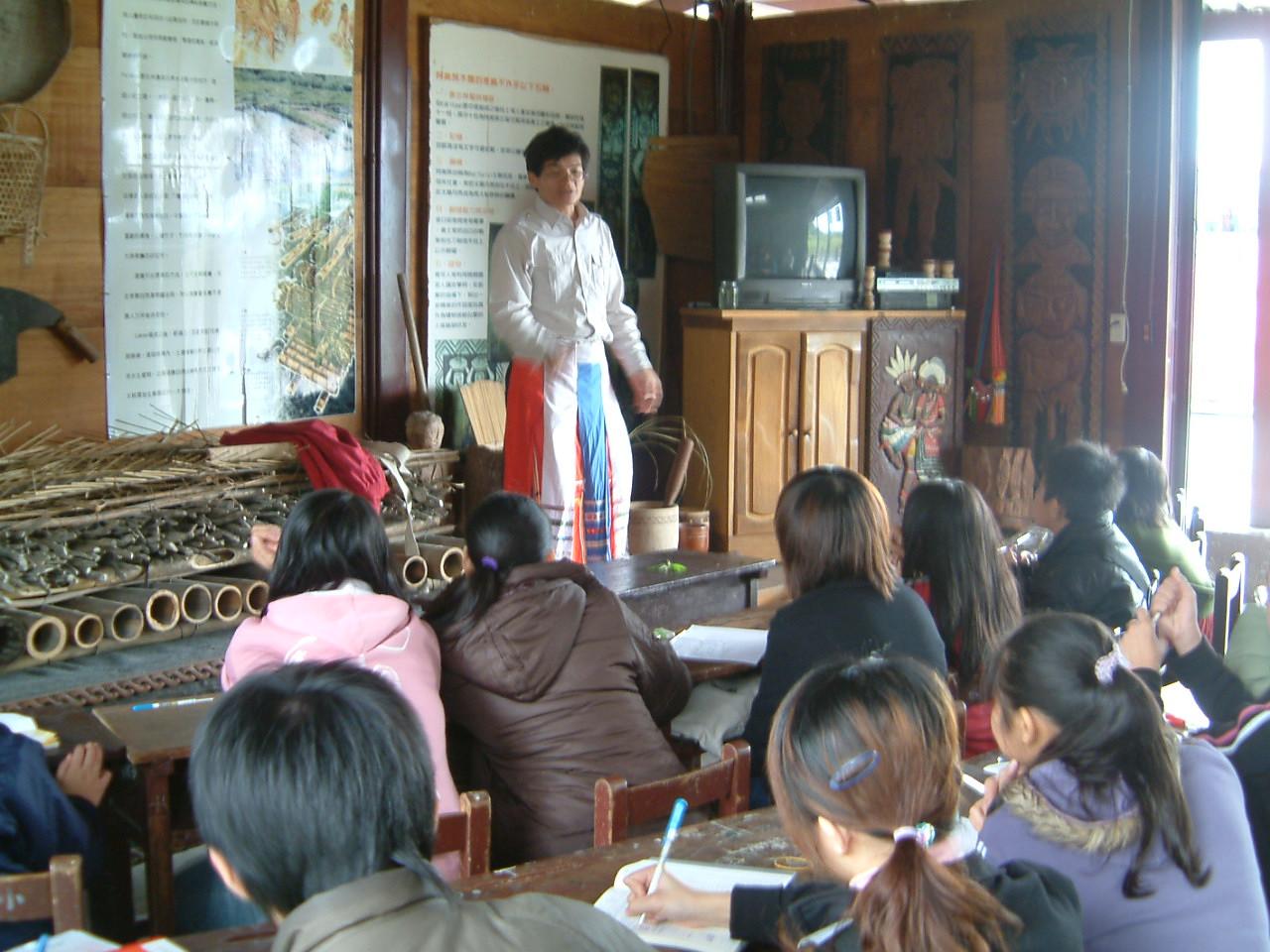
Listening to the instructor during an
overview of Amis traditional costumes.
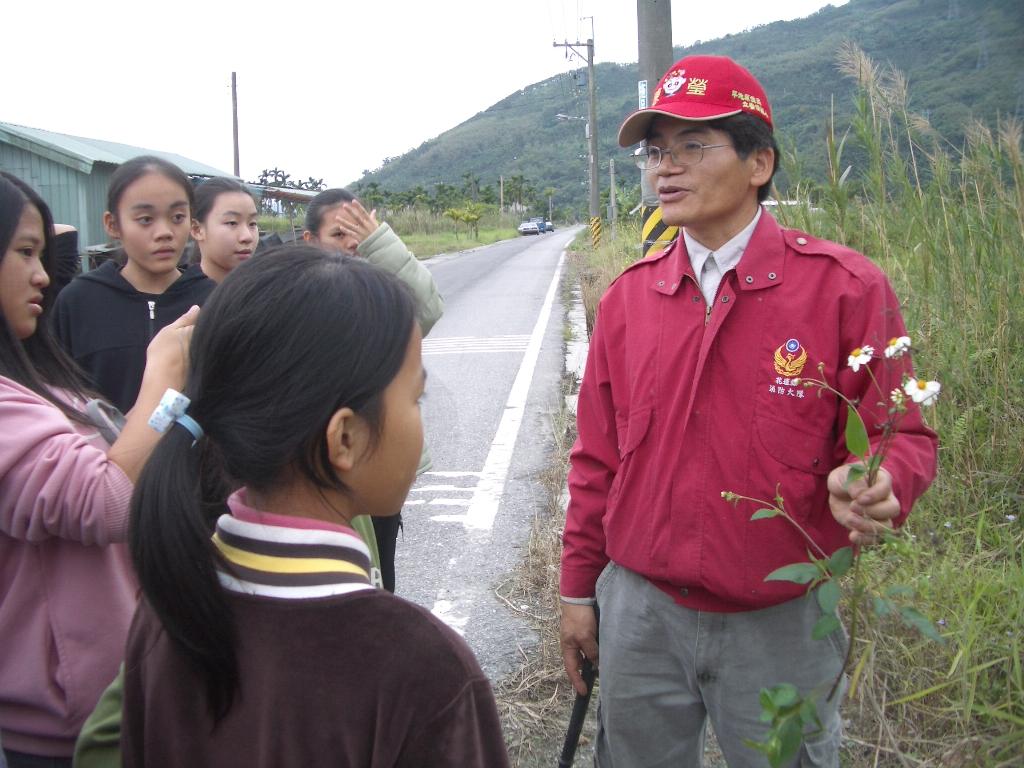
An outdoor trip to locate traditional Amis
food source.
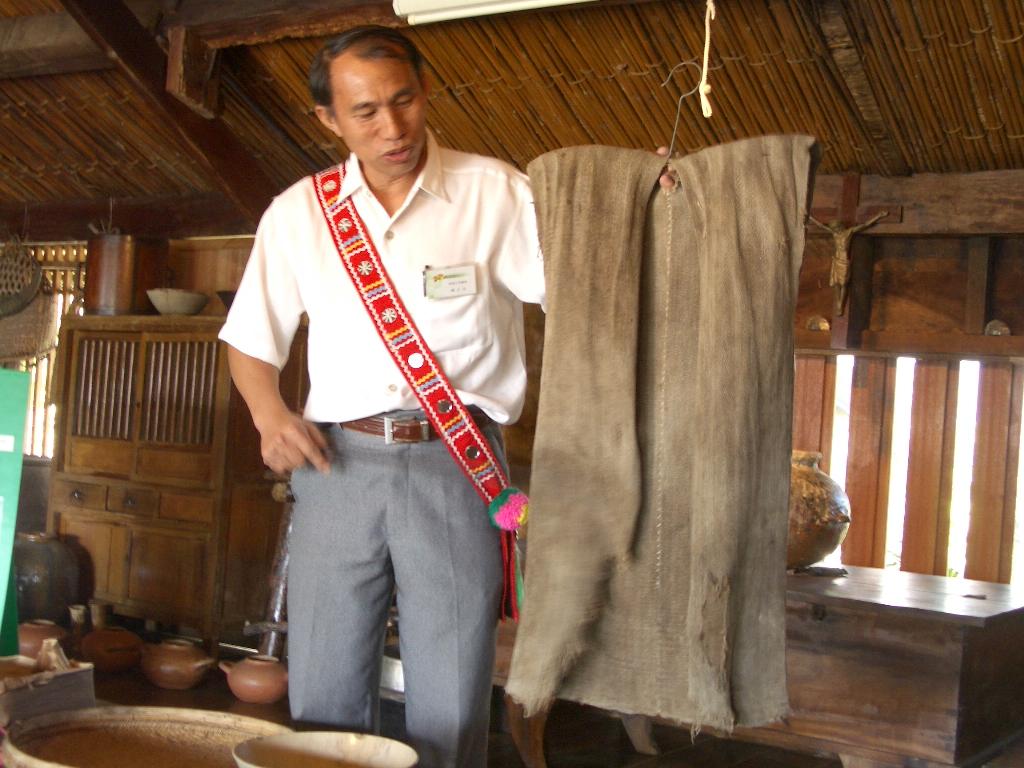
Listening to the instructor in “Old Hous”
during an overview of utensils’ history.
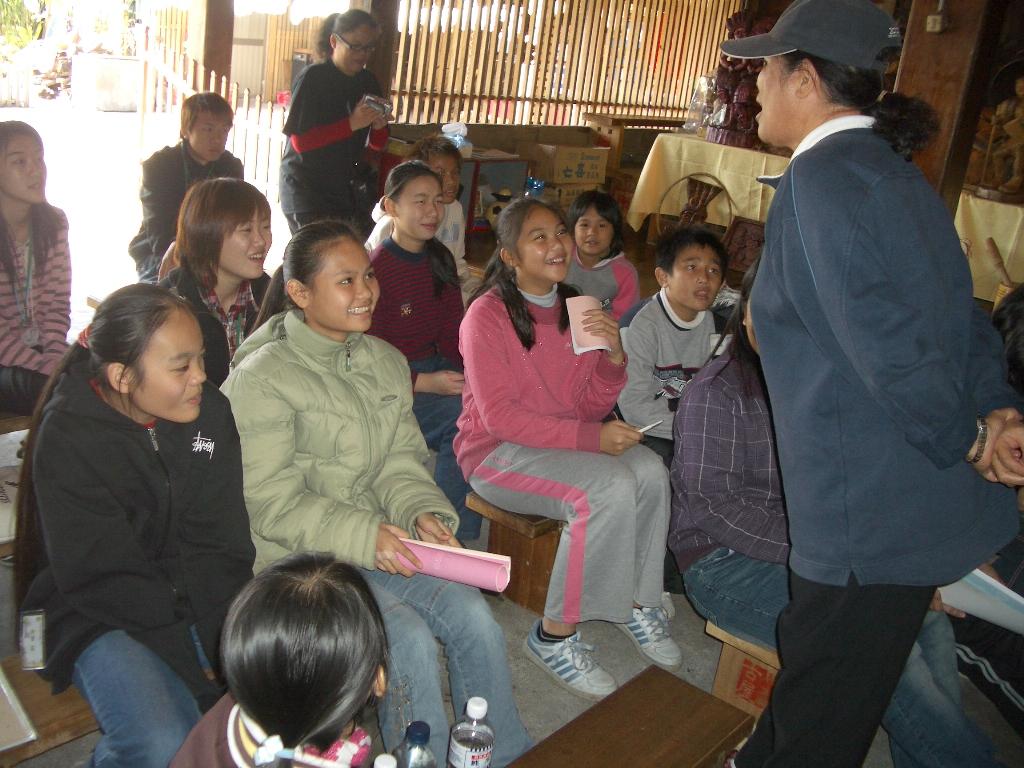
Teaching and singing traditional Amis
children’s nursery rhymes by the instructor.
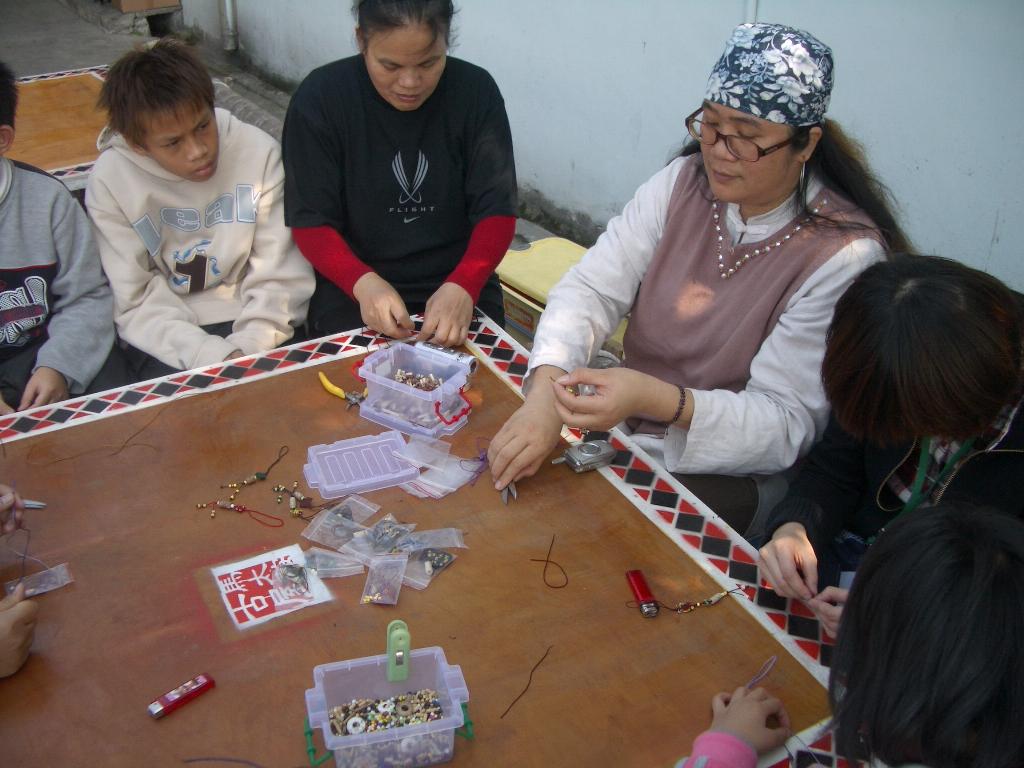
Hands-on experience of making traditional
adornments with the instructor.
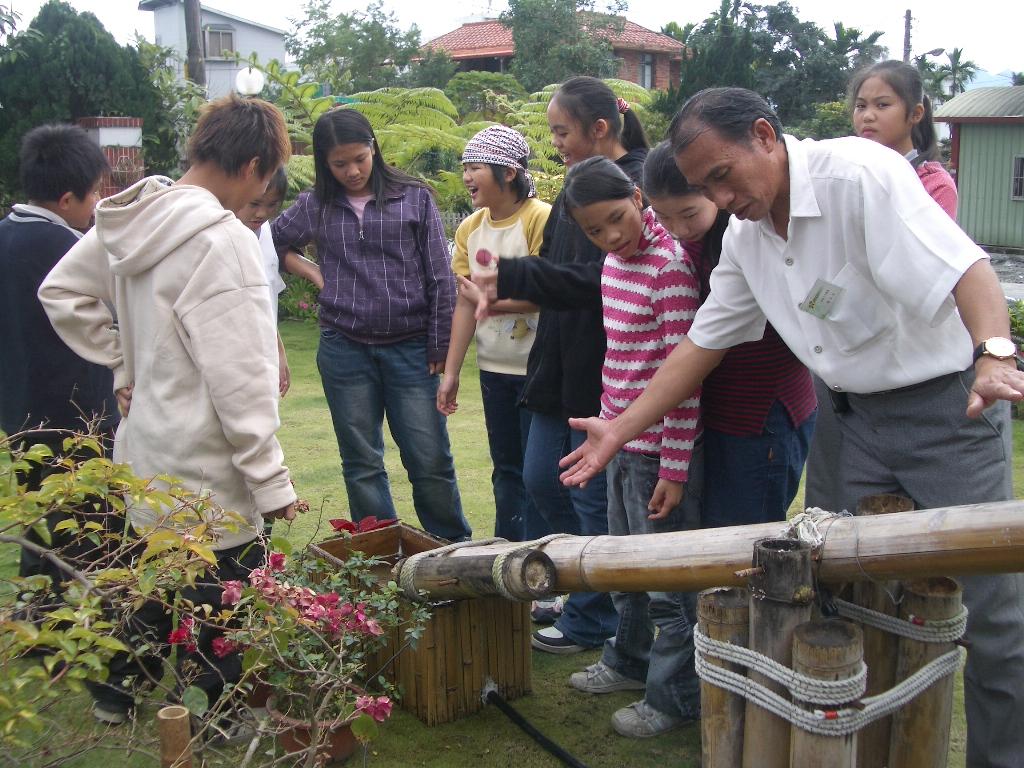
An introduction to knowledge base of Amis
ancestry by the instructor in the outdoors.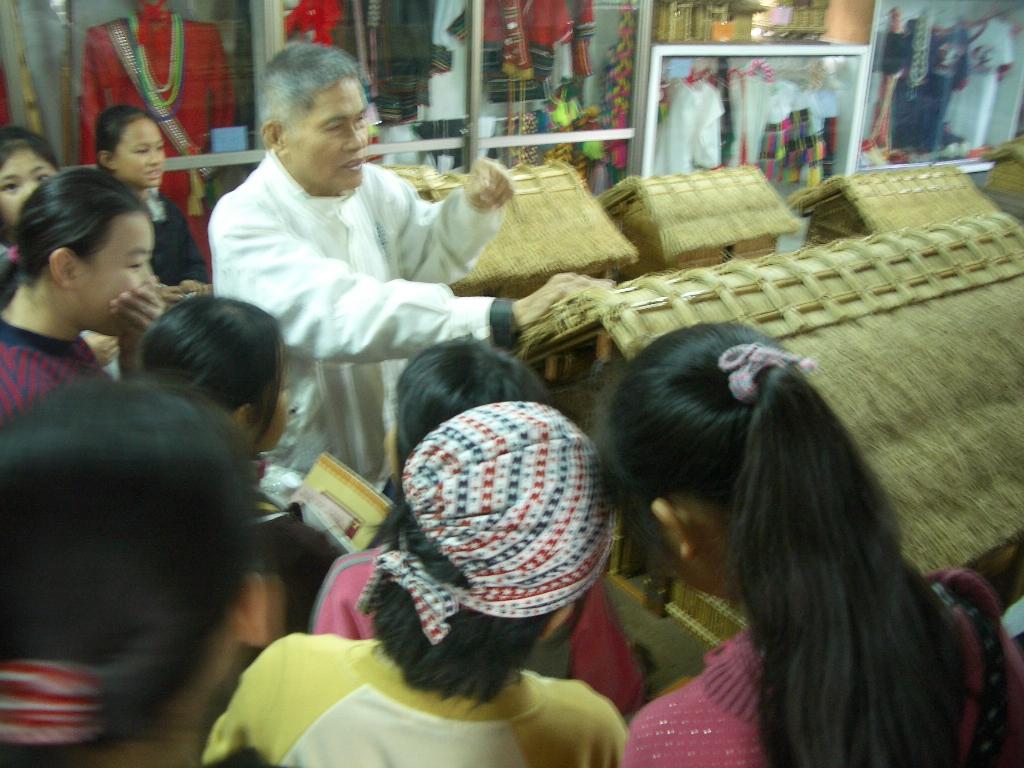
An introduction to traditional Amis
architecture by the instructor.Top
--Documentation--
During our root-searing trip, we fully
utilized our classroom knowledge and
effectively documented things we saw and
heard. We hope to present Amis Culture to
those who are interested to the fullest
extent. For more information about findings,
please check out the information below:
|
Hsiao-ning
Liu |
| 2005.01.25 |
|
Today, we were scheduled for an
interview. The university volunteers
had prepared us for effective
interview skills ahead of time and
conducted a series of interview
practices. In addition, volunteers
had designed a number of curriculums
and helped us in focusing on
important topics. They played a very
important role in grouping and
advising participating students. It
has always been fun and eventful
during our field trips. |
|
2005.01.26 |
|
Fataan’s leaves are in seven colors.
Black leaves symbolize god
worshiping while the rest are
available to eat. Fatann has two
cultural cities, one established
4000 years ago and the other 2000
years ago. Fataan was a matrilineal
society and it was important to
worship the God of Iron and the God
of Wind during knife making. If a
wife threw her husband’s knife out,
she had made up her mind to divorce
him. Because of lacking a naming
system in the past, no major naming
distinctions among aboriginal tribes
could be identified. In Amis
society, there were two tribes, one
was Costal Amis and the other was
Rift Valley Amis. Females are not
required in worship services because
female figures are considered
Goddess or Spirits. In Amis
traditions, holding someone’s pinkie
while dancing is a form of
worshiping God. Holding any other
fingers while dancing implies
casualness. For example, during
Masarut (Harvest Festival), it is
not acceptable to stain the
worshiping costumes. |
| 2005.01.27 |
Q: Why are all enchanter
females? A: Not
necessary! There are a
few sorcerers too.
Q: How does someone
become an enchanter? A:
One must possess
supernatural power to
become an enchanter.
The essential items an enchanter
must have are betel nuts, meat,
sticky rice cake, and wine. A tribal
chief is elected by a tribe and
represents a spiritual leader.
Aboriginals’ houses were mostly made
up with straws and bamboos. It would
take 3 to 4 days to build a house
with 30 people. In traditions, wine
was only available for elderly while
younger generations were supposed to
serve wine. Wine making must be
completed a week before Masarut. |
|
2005.01.28 |
Sabat Stone Pillar is
the legendary place
where all aboriginals
were originated and it
is an ancient tree with
3500 years of history.
In traditions, betel
nuts were only available
for prestigious and
privileged individuals
during important
festivals of sacrifices.
Females were not allowed
to drink wine because
wine was reserved for
priests. Masarut was a
males-focused event
while females were only
supposed to observe the
event. The oldest
daughter typically was
the role model for the
entire family while
other daughters were
free of
responsibilities. In
particular, though
oldest daughters were
supposed to stay with
their own families for
the rest of their lives,
other daughters were
allowed to do so.
Moreover, a tribal chief
was responsible for
everyone’s action.
During the transition of
a chief’s power, the
scepter was the symbol
of transferring power
yet clothes and hats
were not included in the
transfer.
Q: What inspired you to
stay in power for more
than 50 years?
Typically, chiefs stayed
in power until they
died. Due to poor
health, I decided to
retire from the chief
position early.
Q: What are the major differences in
costumes between chiefs and the
general public? A: Hats give away
the distinctions between chiefs and
the rest. In particular, feathers on
the hats symbolize special power. |
|
Afterthoughts |
|
Based on the findings
from our trip to Fataan
and the facts about
Masarut, females played
most significant roles
in Amis culture and
males respected female
authority figures
traditionally. It seemed
unconventional. After
all, a female dominated
society sound foreign to
me. Especially, female
figures were considered
supernatural like God
and devil spirit. Not to
mention the power a
woman had when it came
to marriage.
Over the last four days, I have
learned a lot about aboriginal
culture and traditions. It has been
fun and interesting experience for
me. Special thanks to all volunteers
for your time with us during our
trip. |
|
Top |
|
Si-ting Chen |
|
2005.01.25 |
|
On our way to Hualien, we had so
much fun in the tour bus and I was
so thrilled to have an opportunity
to spend three days with the
university volunteers and my
teammates on this trip. |
|
2005.01.26 |
|
Japanese named this place “Fataan”,
symbolizing men married into brides’
families along with all his personal
belongings. Because women controlled
marriages traditionally, women could
decide ending their marriages by
throwing husbands’ knifes out. In
addition, courting bags were filled
up men’s love and affections for
women they adored. In Amis native
tongue, roads are “La Lan” and taros
are “tali”. Amis priests pray for
good fortunes on behalf of the
general public. |
| 2005.01.27 |
|
Today, we met Mr. Bao-yu Hsieh, the
elderly man in “Old House”. We
discovered that houses were designed
to face east in Amis architectural
culture and the amazing “Old House”
has been around for more than 80
years. This evening, we were
scheduled for a cultural learning
experience, involving traditional
dance and rituals for wine tasting,
taught by an instructor “Maligu”. In
Amis traditions, when elderly men
gestured desires for wine, younger
men must respond to them by serving
wine to them. In additions, we
learned some traditional songs as
well as many words in Amis tongue. |
| 2005.01.28 |
|
Sabat Stone Pillar was built on an
ancient tree fossil and known for
the origin of Amis culture. In the
old days, Amis houses were mostly
made out of straws. We visited a
90-year-old tribal chief who had
lived in Hualien for 46 years and
had 26 grandchildren. In addition,
the chief has been the leader of his
tribe for more than 50 years in
charge of tribal affairs and
responsibilities. |
|
Afterthoughts |
|
After a series of educational
activities exclusively designed for
us, we were very grateful for the
opportunity of an incredible
learning experience. Overall, this
trip was an interesting, eventful,
informational, and authentic
experience. |
|
Top |
|
Chi-hsian
Lin |
|
2005.01.25 |
|
We were scheduled for learning
interview skills this morning and
had a chance to practice with others
in groups. This was a new yet
interesting experience for us for
the first time in our lives we had a
chance to interview others. In the
afternoon, we headed out to Hualien
by a tour bus and had a very
exciting day. |
| 2005.01.26 |
Fataan: Leaves were
smooth and soft to
touch. Black leaves were
used for sacrifices
while others were
edible.
Lotus
à
Cracked leaves
Lotus
à
Bright and shiny beads
of water on round
leaves.
Fataan has two cities of
civilization 2000 to
4000 years ago. In the
early days, glass beads
were used for trading
purposes with the Dutch
and were also know as
“Dutch Beads”. Fataan
had a matrilineal
society and adult males
at the age of 15 were
required to make their
first knife.
[ba gu iun]~ men’s
submissions to women
The highest number:
thousand
[la] ~ teacher; [lan] ~
road.
[Fu din]~ fish; [ba nai]
~ rice.
[siga wa sui] ~ priest
[eilisn] ~ in the midst
of festivals of
sacrifices
Dancing while holding
someone’s pinkie figers
was a form of worshiping
God; Bottom outfits for
males are made up with 3
pieces; the outer piece
is used to cover body
parts.
Unclothed fish: loach,
eel, mudfish, and yellow
eel; inedible due to
parasites.
Unconventional fish:
shrimp, crab, and dragon
larva.
Environment conditions
for fish reproduction:
clean
Large Fataan migration
to Taipei
Large Tabalong migration to
Kaohsiung |
| 2005.01.27 |
Fataan: Pigeonpea
Fataan: 80 years of
history
The elderly of “Old
House”: Mr. Bao-yu Hsieh
Director: born in1952
A sheet of tin plate
topped traditional
styled houses to prevent
roof leakage because
roofs were mostly made
out of straws.
Traditionally,
aboriginal houses were
designed to face east.
Steam glutinous rice:
Maho
Instructor: Maligu
In Changshu, Amei is the
hometown pride while
Bailang is the
equivalent in Guangfu.
Bagelongnai: the
littlest
Wine making was a way of
life; there were no
commercial wine
available in the early
days
Rice malt is made with
12 varieties of herbs
and shall be ready a
week before Masarut
Sister: Safage: Gegai |
| 2005.01.28 |
|
Pillars have been moved around
previously and one of them has been
permanently removed. Remaining items
scatter around. There had been many
giant trees in the past though they
are no longer standing. Pillars were
designed to hold up a house and
provide a shelter. The area is known
for tourist attraction because of
its beautiful sceneries. An ancient
tree had transformed into fossils.
What an amazing site! |
|
Afterthoughts |
|
I had a great opportunity to learn
traditional fishing method from Mr.
Tsai today. In addition, I learned
the importance of an adult male’s
knife earned at the age of 15. A
man’s knife signified his life and
future because a woman had every
right to divorce her husband by
throwing his knife out of the door.
Therefore, men were supposed to work
hard and be productive or futures
would be less promising. |
|
Top |
|
Yi Bao |
|
2005.01.25 |
|
We learned how to improve our
interview skills and had a chance to
practice with teammates and the
university volunteers in groups.
Though we were still new when it
came to interview others, we found
it very interesting. When we were
told that we would be interviewing a
tribal chief and skilled craftsmen,
we were extremely anxious on our way
out to Hualien. It took the entire
afternoon to get to our destination.
By the way, we were not impressed
with our bathroom shower facilities. |
|
2005.01.26 |
|
Fataan is a type of
pigeonpea. In the early
days, characteristics of
Fataan culture included:
two cities of
civilization; an adult
male would earn a
lifelong knife at the
age of 15; matrilineal
society; thousand was
the highest number; rice
was called “ba nai”,
holding others’ pinkie
fingers symbolized
worships, the bottom
part of male costumes
were made up with 3
pieces and the outer
piece was designed to
cover body parts.
Unclothed fish: loach,
eel, mudfish, and yellow
eel; Without protective
layers, these fishes are
inedible due to
parasites; known for
being active at night.
Unconventional fish:
shrimp, crabs, and
dragon larva.
Large Fataan migration
to Taipei and large
Tabalong migration to
Kaohsiung. |
|
| 2005.01.27 |
|
The “Old House” in Fataan has 80
years of history and was built out
of wood, bamboos, and straws. In
1953, the house was reconstructed
due to a family split and part of
wood structure was removed. The
house was originally designed to
face east though the house was
manually repositioned later due to
the area’s new construction. In the
early days, clothes were made with
linen fabrics. During Japanese
Occupation, cotton clothes became
popular. A-mei Tian was once a track
and field contestant in many
national and international sports
events including Asian Games and
World Games. In addition, she taught
Sports in Guang Fu Middle School.
Her childhood memories of food
included yams, manioc, Flying spider
monkey tree fern, and taros. We
visited Mr. Guang-hui Chou, an
architectural craftsman, and learned
a lot about everyday household items
such as adornments made out of dead
animal teeth or bone and toys made
out of coconut shell. During this
visit, we learned that there were
three floors in a typical straw
house; the first floor was made out
of bamboos; the second floor was
made with wood; the third floor was
put together with straws. We even
learned how to carve and sand wood
sculptures for artistic prints under
Mr. A-long Lin’s guidance. In the
evening, Mr. Maligu gave us an
overview of wine culture and bancha
songs. In the early days, wine was
only available during Masarut and
rice malt used in the wine making
was made with 11 varieties of herbs. |
|
2005.01.28 |
Sabat Stone Pillar is
made out of tree fossils
and symbolizes
sacredness with over
3500 hundred years of
history. Masurut is a
male-focused festival.
In the early days, betel
nuts were reserved for
the privileged or
nobility.
[mi da bi] ~
appreciating someone
else’s ability to handle
things.
Interview with the
tribal chief:
Q: Why did you agree to
accept the chief
position?
A: I started right after
I got out of military
and have been doing the
job for 57 years.
Q: How old are you?
A: 86 years old.
Q: What are your major
responsibilities as a
chif?
A: I am responsible for
everyone’s action.
Q: How long have you
live here?
A: 46 years.
Q: May we have the honor
to hear your song?
A: Sure.
Q: What are the major
differences in apparels
between a chief and
ordinary people?
A: The position of the
feather worn on the head
gives away one’s
identification. Not
everyone is allowed to
wear feather on the
head. Besides, a chief
has a scepter while
enchanters are dressed
in blue and the rest is
dressed in red.
Q: Why did you make a
decision to retire after
57 years as a chief?
A: In general, a chief’s role is a
lifelong position. However, I
retired after 57 years because of my
health issues. |
|
Afterthoughts |
|
We visited many places of interest
and gained a great deal of knowledge
in our culture. At night, we
wondered around outdoors catching
frogs and watching green tree
vipers. One of the visits was
learning to make wood sculptures
from Mr. Tsai. By the way, the place
we stayed overnight was near a
cemetery and it was quite a scary
experience. During this trip, we had
a chance to taste traditional
aboriginal cuisines everyday.
Although some of those dishes did
not interest me such as Birds’ net
fern, I enjoyed the idea of having
fish and lemon in every meal. Based
on the customs of Amis matrilineal
society, women were the dominating
force of the society in which men
were married into women’s families
and women had rights to divorce her
husband for any reasons. By and
large, It has been a fun and
educational trip for me. |
|
Top |
|
Shin-ci Yang |
| 2005.01.26 |
|
I saw a selection of
fishing gears and
igniting utensils.
Some of the
characteristics in Amis
culture are:
-
Men were married into women’s families.
-
Only women have rights for inheritance.
An adult male earned his
first knife at the age
of 15.
Priest: ci gow wa sai
Eelisin: in the midst of
festivals of sacrifices.
The 9th song:
5 notes
Amen: means I
acknowledge or I agree.
There are three types of
fish as below:
Unclothed fish: loach,
walking catfish, and
more
Unconventional fish:
shrimps, dragon larva,
and more
Clothed fish: a number
of them
Paiakaw means areas by
riverbanks, swamps, or
areas with plenty of
water sources.
Hundred: [li an]
Thousand: [ba de gang]
Ten: [bu lu] |
|
| 2005.01.27 |
|
FaDaAn= Pigeonpea
Fataan Old House: with
80 years of history.
Director was born in
1952.
The owner of “Old
House”: Mr. Bao-yu Hsieh
The straw roof was
topped with a sheet of
tin plate prevent water
leak during the rain.
In the early days, Amis
houses were mostly
designed to face east.
East=WaLi
West=DiPan
South=DiMorLa
North=YaMis
Rice malt=DaMor made
with 12 varieties of
hearbs and must clean
the herbs prior to use
The littlest =BaGaLonNi |
|
| 2005.01.28 |
|
Sabat is the origin of
Amis culture.
One of the pillars was
supposed to be taken
away from the current
location. Some of the
original settings remain
intact.
Pillar = SaDoKu
There were lots of trees
here in the early days.
Daughter= KaDaFu
The characteristics of
Amis culture:
A 3500 year old tree;
betel nuts were only
available during
festivals of sacrifices
and for the privileged
only; women were not
allowed to drink wine
though enchangers were
able to.
Men were in charge of
outdoor affairs while
women managed household
tasks. In addition,
Masarut is a male
focused festival.
Appreciating how a woman
present herself= MiDaPia
The oldest daughters
ruled households and
were supposed to stay
with here families for
her lifetime.
-
Why did he accept the position of a chief?
During Japanese
Occupation, he
graduated from
Hualien Agricultural
College and became
an official
representive. After
he retired from his
government position,
he was elected for a
tribal chief
position and has
been in the same
position for 55
years.
-
How old is the chief?
He is 84 years old
or may even be 86.
Similar to a leader
in a community, a
chief generally
remain in power
until he died.
However, the chief
had to retire early
due to poor health.
The old chief had 5
sons and 5 daughters
with a total of 26
grandchildren.
-
How long have the chief lived here?
46 years.
-
May we have the honors to hear his song?
At first, he was
unable to sing to
us. However, we had
the honors to hear
his songs at last.
-
What are the major distinctions in accessories between
a chief and
ordinary people?
The position of feathers
symbolizes a role a
person plays. Therefore,
there are rules and ways
to dress up according to
Amis culture especially
when it comes to wear
hats. |
|
|
Afterthoughts |
|
It is a rare opportunity for me
to get to enjoy a nice trip like
this. On our way to Hualien, I
was feeling nauseated and once I
even threw up.
On the second day, we arrived at Mr.
La Lan’s house. According to Mr. La
Lan, we learned that he was born
along a roadside. Everyone cracked
up and burst into laughter. On the
third day, we visited “Old House”.
Ms. Tian taught us traditional
children nursery rhymes and
authentic dance. We also got to play
with ceramics and decorative items,
something I had never tried before.
In the afternoon, we went to an
artist specialized in Amis
sculptures. He shared some stories
with us and gave us an opportunity
for hands-on experience in making
sculptures. On the 4th
day, we were scheduled to visit
Sabat Stone Pillar; a magnificent
place amazed all of us. |
|
Top |
|
Chi-wen
Chang |
|
2005.01.26 |
|
[FaDaAn]: Fataan
Lotus: shines when come
in contact with water.
Lotus: no changes when
come in contact with
water.
Amis glass beads were
used to trade with
“Dutch beads” in the
early days.
Matrilineal society: Men
were married into
women’s families and
men’s personal
belongings were
transferred to women
they married.
Knife
à
knife handle
à
knife sharpener
à
knife pocket.
Men earned the right to
make his first knife at
the age of 15.
LaLan=Road
SiGaWaSi=Priest
Eelisin: in the midst of
festivals of sacrifices
Dancing with holding
someone’s pinkie fingers
symbolized worships
while dancing with
holding someone’s hands
was a common form of
dance.
The 7th song
“Mama’s child” signifies
the courtships between
women and men.
The middle piece of a
male’s bottom outfit was
designed to cover body
parts.
Courting bags are filled
with love and affection.
A man is supposed to
marry whoever the new
owner of his courting
bag is. A woman is given
opportunities to take
away the courting bag of
someone she favors the
most.
Amen: I agree or I
praise.
There are three types of
fish as below:
Unclothed fish: loach,
walking catfish, and
more
Unconventional fish:
shrimps, dragon larva,
and more
Clothed fish: a number
of them
Do not set free the
caught fish because the
story has it that once a
fish is set free, other
fishes will never come
near the area. |
|
| 2005.01.27 |
In the early days, FaDaAn was
used in Amis diet when there was
no other food available.
The owner of “Old House”, Mr.
Bao-yu Hsien, indicated that the
house had more than 80 years of
history.
In general, a house was made out
of bamboos, straws, tin plates,
and wood. An Amis house was
designed to cool down in summer
and warm up in winter.
It required 4 people to move one
pillar for a total of one day.
Past customs described as below:
Dining: serving meals with
ratten made plate and drinks
with bamboo made cups.
Clothing: made out of animal fur
or man-made fabric.
Living: straw house
Transportation: by foot.
Mahor: rice steaming bucket
East: WaLi
West: DiPaM
South: DaMor
North: Amis |
| 2005.01.28 |
Interview details:
Why did you accept the chief
position?
During Japanese Occupation, he
became an official reprehensive
after graduating from Hualien
Agricultural College. After retired
from the government position, he was
elected for a tribal chief position.
It has been 55 years since he
started the position and he is now
81 years old. The chief is in charge
of tribal affairs as a whole and at
an individual level. He has 26
grandsons among which 10 are girls.
He called this place home for the
last 46 years. |
|
Afterthoughts |
|
On January 25, it was finally the
moment for our root-searching
journey to Hualien. We met Mr. La
Lan and he explained he was named
after “Road” because he was born
alongside of a road. After we
arrived at “Old House”, we were
scheduled for a series of activities
such as pounding and mixing
glutinous rice flour, making
ceramics, and making ornaments. Mr.
Yang pointed out that it required 4
people to move a pillar. Ms. Tian
taught us traditional songs and
dance. Mr. Guang-hui Chou had earned
numerous baseball trophies. He said
that roofs were built out of betel
palm trees and straws in the early
days. I was pretty amazed by that.
Later, we went to visit Mr. A-long
Lin for an educational and hands-on
experience in wood sculptures. On
the last day, we were scheduled for
Sabat Stone Pillar, an impressive
creation of nature and human. In
addition, we learned that Sabat
Stone Pillar was a sacred site with
amazing legendary tales. |
|
Top |
|
Ting-an
Hsueh |
|
2005.01.25 |
|
We had our interview skill course
this morning and I was teamed up
with my best friend to practice the
interviews. Later, I got to practice
with the university volunteers and
they were extremely helpful. As a
whole, our ride to Hualien was a fun
filled event though I was exhausted
by the time we got there. |
|
2005.01.26 |
The first thing we were
scheduled for was a visit to
Fataan to learn more about
traditional fishing gears and
fishing methods from Mr. Hsueh.
In addition, we learned more
about interesting legendary
tales; women had total control
over men in marriages and were
able to divorce men by throwing
their knife out of the door; men
earned their first knives at the
age of 15; during festivals of
sacrifices, men were dressed in
traditional costumes made up
with several components serving
distinctive purposes; the 9th
song has 5 notes.
There are three types of fish as
below:
1.Unclothed fish: loach, walking
catfish, and more
2.Unconventional fish: shrimps,
dragon larva, and more
3.Clothed fish: a number of them
Hundred: [li an]
Thousand: [ba de gang]
Ten: [bu lu] |
| 2005.01.27 |
|
Fataan’s “Old House” has over 80
years of history and the
structure has been preserved
over the years. The roof of the
house was made out of wood,
bamboos, straws, and tin plates.
Based on Fataan’s customs,
parents are supposed to use a
piece of log as a wedding
present for each one of their
children. Therefore, the
structure of “Old House” had
been modified. In the early
days, it is common to make
household utensils with wood,
tree barks, and bamboos.
Similarly, the simple life style
was applied in clothing too.
Mrs. A-mei Tian was once a
nationally renowned in track and
field.
Wood sculpture: We had an
opportunity to get our hands on wood
sculpting. In general, a plain
statue sculpture takes one to two
hours to complete. Quite a job! |
|
2005.01.28 |
Q: What made you to take on a
chief position?
A: After graduating from Hualien
Agricultural College, I had been
involved in making policemen’s
uniforms. Because there was a
need for a tribal leadership, I
decided to take on the
responsibilities.
Q: How old are you?
A: Ninety.
Q: What are the main
responsibilities of a chief?
A: Work with government
authorities and local community
leaders.
Q: How many grandchildren do you
have?
A: 26
Q: Where is your tribe located?
A: Fenglin
Q: How long have you been a
chief?
A: For more than 50 years.
Q: What are the major
distinctions in costumes and
accessories between a chief and
ordinary people?
A: Feathers can be used by anyone.
Costumes and hats of a chief will
not be passed on to the next chief.
However, the transfer of a chief’s
scepter symbolizes the transfer of
the power. |
|
Afterthoughts |
|
We were looking forward to our
Haulien trip except for room
arrangement because I was not
grouped in the same room with my
best friends. Fortunately, it all
worked out the next day. I am very
thankful for the opportunity to
participate in this meaningful event
and to create the memory of
lifetime. |
|
Top |
|
Pei-jun Hwang |
|
2005.01.25 |
|
We were scheduled for learning
interview skills today. We were told
that we would be interviewing the
two people on our textbook. During
our interview practice, one of the
university volunteers was shooting
our performance with his DV. On our
way to Hualien, we saw lots of
beautiful sceneries and also took
many pictures of them. |
|
2005.01.26 |
Why is “fa da an” also named
Fataan?
“Fataan” was named by Japanese.
There were seven colors in
Fataan culture: black was for
worship while food in other
colors are safe to eat. Fataan
had two wave of civilization;
one of them took place 4000
years ago. During knife making,
it was important to worship God
of Iron and God of Wind. When a
woman threw her husband’s knife
out of her door, a man would be
destined to leave the marriage.
da ku rur, da te kem
lalam =Road
Priest (si kau wa sai) were
available to rename one’s name
ta li = taro
There are tree type of fish:
1.Unclothed fish: Due to a lack
of scales for protections,
fishes of this type are not free
of parasites. Examples of this
type are loach, eel, walk
catfish, yellow eel, and perch.
2.Unconventional fish: shrimp,
crab and alike.
3.Clothed fish
Why do most Amis natives migrate
to Taipei?
Due to a lack of employment
opportunities in Hualien, most of
Amis natives have been more positive
about employment in Taipei. In the
past, Amis natives were originally
called “foreigner” or “Amis” in
Taipei. The name “Aboriginal” was
created later. One of the
characteristics of Amis culture
prohibits drinking prior to Masarut. |
| 2005.01.27 |
|
[ka ki da an] means
Fataan and also means
pigeonpea.
Fataan has an
80-year-old “Old House”
whose owner is Mr.
Bao-yu Hsieh. The
director of “Old House”
was born in 1952. The
roof of this house was
covered with a sheet of
tin plate to prevent
water leak. In early
days, most houses were
designed to face south.
Maho: used for steaming
glutinous rice
A-mei Tian: Once a
national contestant in
track and field and a
teacher, she is 60 years
old and retired from
teaching four years ago
East: WaLi
West: DiPaM
South: DaMor
North: Amis
Breakfast: di mo er
Lunch: ma la lan
Dinner: ma di fi
Mr. Guang-hui Chou:
A barn was used to store
rice. The camphor tree
has over 100 years of
history.
Q: Why are enchanters
women?
A: Not necessary. There
are also male
enchanters.
The straw house was made
out of straws and
bamboos. Though it was
once a residence for a
prestigious family, the
house had been vacant
for years and was then
turned into the family
shrine. Each room had
taken a month to
renovate using bamboos
as main construction
materials.
Mr. A-long Lin
A plain sculpted wood
statue takes one to two
hours to complete.
The youngest child: [ba
ga long nai]
Elderly: [ma du a sai]
Nice drink: [ga shou ai]
This wine: [gu er ba he]
Uncle: [sa ni fa gi]
Dried up: [da wu wa ge]
Therefore I: [han nu ma
gu]
Rice malt: [ da mer]
made with 12 varieties
of herbs. During wine
making, both mind and
body must be purified. |
|
| 2005.01.28 |
In Amis traditions, houses were
built out of straws.
[Tu lu en]: pray
Tree fossils: [sa pa] was the
origin of Amis culture though
other ethnic groups had settled
around this area. Traditionally,
betel nuts were only available
to the privileged. To impress
the woman he adored, a man was
supposed to send fire logs to
the woman’s family secretly.
Upon her acknowledgement, the
man would try his best to
impress her family.
Ka la law = tribe
We interviewed Ms. Hui-mei Lin’s
father and went over topics about
his 50 years of experience as a
chief in Fenglin. |
|
Afterthoughts |
|
Over the last 4 days, I had one of
my best moments in my life. Each
learning experience was fun filled
and informational. On the morning of
the first day, we were scheduled for
a music lesson and later an
interview course. In the interview
course, we had not only learned the
theories but also practiced
interview skills in groups. Overall,
the course was designed to learn
interview skills in creative ways
and we had a great time in learning.
As soon as the interview course was
dismissed, we started to head out
for our trip to Hualien. After a
long bus ride, we arrived at Hualien
in the evening. In the next few
days, we saw lots of beautiful
places. One of my memorable moments
was the night out for the discovery
of the nature. We saw tree frogs and
even a green tree viper. |
|
Top |
|
Pei-chi
Hwang |
|
2005.01.25 |
|
Our music lesson lasted till noon
and we were then scheduled for an
interview course. After lunch, we
couldn’t wait for our trip to
Hualien and our ride was as much fun
as I had anticipated. |
|
2005.01.26 |
|
We were ready to head to Fataan
from the church. In the early
days, Fataan was a matrilineal
society with many amazing
traditions: an adult male at the
age of 15 earned his first knife
with a bunch of straws tied to
the handle; a total of 14 songs
were played in festivals and
each served a distinctive
purpose. During the 7th
song, a woman was allowed to
take away the courting bag of a
man she adored, a symbol of
love. S
Fataan was well known for the only
one of its kind fishing method.
According to Fataan’s customs, there
are three types of fish. Examples of
“unclothed fish” are loaches,
walking catfishes, eels, and yellow
eels. “Unconventional fish” includes
shrimps and crabs while “clothed
fish” are Tilapias and alike. We had
a chance to practice our fishing
skills using triangle fishing-nets.
At last, my catch was by far the
largest. The instructor was so much
fun and I had the best time in
fishing. |
| 2005.01.27 |
|
We were scheduled to go to the
red-roof house this evening for
dinner and a cultural experience
with Mr. Maligu. Over the course of
cultural learning, we were told to
follow what Mr. Maligu instructed us
to do. In addition to learning
traditional music, we discovered
that wine was only available to
tribal elderly during Masarut and
over drinking was neither socially
acceptable nor accepted by wives.
|
|
2005.01.28 |
|
We visited Sabat Stone Pillar today
and learned the sacredness of this
place. Traditionally, tribesmen were
not allowed to get close to the
pillar. The nearby road was once
designed for expansion and the
pillar was supposed to be relocated
to a different location. The story
had it that a futile government
effort to relocate the pillar was
not meant to be. As a result, the
new road was built around the pillar
instead. It was amazing to hear that
we were able to preserve the pillar
with 3000 to 4000 years of history. |
|
Afterthoughts |
This 4-day trip was very eventful
yet educational. We had a great time
in singing songs on our bus ride to
Hualien. Thanks to the participating
volunteers, we were scheduled for a
series of educational courses and
events such as ceramics, wood
sculptures, and more. We were
excited about the opportunity to
explore traditional arts and craft
especially the hands-on experience
in the making of own crafts. Thanks
for everyone’s help. Let’s keep in
touch.
|
|
Top |
|
Jia-yuan Lo |
|
2005.01.25 |
|
We were scheduled for an interview
course at the music room this
morning. At first, we learned the
tips on how to conduct an effective
interview. Later in the class, we
were grouped teams to practice our
interview skills among the
university volunteers and ourselves.
After the class was dismissed, we
got ready for our trip to Hualien.
It was a long bus ride but we had so
much fun during the ride |
|
2005.01.26 |
1.Fadaan is soft to touch and is
rich in colors. There are seven
colors in fadaan: long black
leaves are for worship while
others are edible. In addition,
there are two types of lotus,
one with shiny beads of water on
the leaves and the other with
cracked leaves.
2.There were two waves of
civilization in Fataan’s
history, one took place 4000
years ago and the other took
place 2000 years ago. The second
wave of civilization formed the
current Fataan culture.
3.In early days, trading
activities were based on
exchanging glass beads and Dutch
beads.
4.Fataan was a matrilineal
society.
5.An adult male at the age of 15
earned the privilege to make his
first knife.
6. A.[ba lu lan]: men’s
submission to women
B. The highest number is
thousand.
C.[fu din]- fish, [ba nai]-rice
D.[si ga wa sai]- priest.
E.ei li sh- during the
festivals of sacrifices.
7.Dancing with someone by
holding pinkie fingers was a
form of worship.
“palakawu” is a traditional Amis
fishing method in Fataan.
There are three types of fish:
Unclothed fish: loach, eel,
mudfish, and yellow eel; Without
protective layers, these fishes
are inedible due to parasites;
known for being active at night.
Unconventional fish: shrimp,
crabs, and dragon larva.
Large Fataan migration to Taipei and
large Tabalong migration to
Kaohsiung. |
| 2005.01.27 |
|
We were scheduled for Ms. Tian’s
cultural learning lesson by which we
learned traditional children’s
nursery rhymes and authentic dance.
We were impressed by Ms. Tian’s
lifetime achievements in track and
field and her famous event in World
Games, in which she was few points
shy from winning a bronze medal. We
were also encouraged to practice
beading and ceramic making. Though
we had a few difficult moments
during the making, we enjoyed the
overall experience in learning
traditional arts and crafts. In
particular, I was inspired by the
quality of the craftsmanship
demonstrated by the instructor. In
the afternoon, we were invited to
Mr. Guang-hui Chou’s workshop; a
place built in Amis traditional
style and filled with Amis style
arts and crafts. We were surprised
that the architecture of Formosan
Aboriginal Culture Village was based
on the design of Mr. Chou’s
workshop. We then visited Mr. A-long
Lin’s workshop where we learned our
first lesson in wood sculpting. I
was overwhelmed by the details
involved in such wood works though I
finally completed my first wood
sculpture, of course with lots of
help from our volunteers. |
|
2005.01.28 |
|
Today, we arrived at
Wuhe Terrace and the
origin of Amis culture,
Sabat Stone Pillar. I
found it intriguing to
learn the historic
development of Amis
culture and the stories
of the two giant
pillars. In the
afternoon, we headed out
to Fenglin to visit a
tribal chief. During the
visist, someone asked
him his reason to accept
the position as a chief.
Because the chief was
speaking in his native
tongue, Ms. Hui-mei Lin
translated the
conversions for us. He
answered that it was an
honor to serve his own
tribe and he had been
doing that for 55 years.
|
|
|
Afterthoughts |
|
This was my first time
to visit Hualien and I
was very excited about
the opportunity to
explore Amis culture
through this trip to
Haulien. In Fataan, we
learned all sorts of
information from Mr.
Tsai especially palakaw.
We also had a chance to
taste the famous stone
grilled steam pot. What
a delicious meal! In the
evening, we had a nigh
out for discovering the
nature. While we
wondered around outdoor,
we saw Moltreche's green
tree frog with beautiful
green skin and a
poisonous Chinese green
tree viper with a giant
head. We were told to
stay away from the viper
because fatalities could
be involved if bitten by
one. Over last four
days, I learned lots of
Amis words, songs, and
traditions from Mr.
Maligu. In particular,
the making of chestnut
wine involved a number
of restrictions. As a
whole, I enjloyed this
trip and the wonderful
learning experience.
Looking forward to
future events like this. |
|
|
Top |
|
Wei-jie
Hwang |
|
2005.01.25 |
|
After breakfast, we met up at the
music room with a group of
volunteers from Christian Chun Yuan
University. Their main
responsibilities included advising
our team in a variety of settings
such as drawing up our interview
targets. Because I fell asleep on
our way to Hualien, I was completely
energetic for adventures by the time
we got there. |
|
2005.01.26 |
|
We spent time outdoors this morning.
After catching a giant fish and some
shrimps, we toured around and
enjoyed the countryside beauty. In
the afternoon, we stuffed rice in
bamboo culms. We had a great time at
dinnertime though my rice was too
sticky. During our night out, we
spotted tree frogs making a lot of
noises. |
| 2005.01.27 |
|
In Fataan’s “Old House”, we listened
to Ms. Tian’s stories about her past
and athletic achievement in track
and field. She also taught us
traditional nursery rhymes and
authentic dance. Later, we learned
to mix glutinous rice flour and make
traditional deserts. Moreover, we
got to make ceramic mugs and I was
very impressed how well it turned
out this time. In the afternoon, we
went to Tabalong and paid a visit to
Mr. Guang-hui Chou, an architect
specialized in Amis straw houses.
Inside of his house, there were many
miniature straw houses. He pointed
out that straw houses were made up
with wood, bamboos, and straws. In
addition to straw houses, he also
had a collection of traditional Amis
utensils such as spoons made out of
cow bones, bowls made with betel
palm leaves, and more. Lsater in the
afternoon, we stopped by Mr. A-long
Lin, a skilled wood sculptor. During
our visit, we were given a piece of
wood to practice sculpting. We
outlined our designs using hammers
and sculpting knives and sand the
carved wood. At last, we topped our
wood with some paint to create
beautiful prints. I was told that I
did the best job among the team
because my design was clearly
outlined. At dinnertime, Mr. Maligu
gave us an overview of wine culture.
We discoverd that wine was very
precious in the early days and was
only available during Masarut. In
addition, it was crucial to keep a
clean body and mind during
traditional wine making or it would
not succeed. |
|
Afterthoughts |
|
Though I had been to Hualien with my
family before, I had a totally
different experience this time.
During this trip, I had much more
fun touring with my teammates and
learning from many experts
knowledgeable in Amis culture.
Though the trip only lasted for four
days, it created memories of
lifetime for me. Looking forward to
more opportunities like this in the
future. |
|
Top |
|